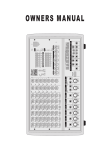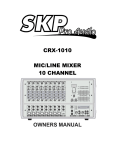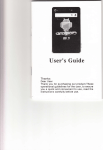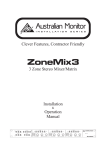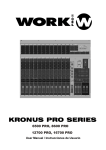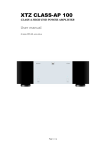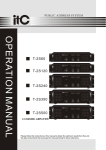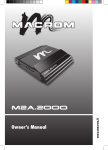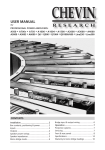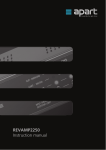Download 8, 12, 16 CHANNEL MIC/LINE MIXER OWNERS MANUAL
Transcript
8, 12, 16 CHANNEL MIC/LINE MIXER OWNERS MANUAL A. INPUT CHANNEL SECTION 2~3 B. MASTER SECTION 4~6 C. MIXER OUTPUT SECTION 7 D. POWER SECTION 8 E. INSTALLATION 8 F. CONNECTIONS 9 G. APPENDIX 10 8, 12, 16 Mono Input Channels with silver plated XLRs and balanced Line Inputs Ultra-low noise discrete Mic Preamps with +48 V Phantom Power Extremely high headroom - offering more dynamic range Balanced Inputs for highest signal integrity Ultra-musical 3-band EQ+FREQ on all mono channels Peak LEDs all Mono Channels 2 Aux Send per channel for external effects and monitoring 2X256DSP Digital of the effect system inside Separate Master Mix, Headphone Outputs 2-Track Inputs assignable to Master Mix Highly accurate 12 segment Bargraph Meters SAFETY INSTRUCTIONS CAUTION: To reduce the risk of electrical shock, do not remove the cover (or back). No user serviceable parts inside; refer servicing to qualified personnel. CAUTION RISK OF ELECTRIC SHOCK DO NOT OPEN WARNING: To reduce the risk of fire or electrical shock, do not expose this appliance to rain or moisture. This symbol, wherever it appears, alerts you to the presence of uninsulated dangerous voltage inside the enclosure - voltage that may be sufficient to constitute a risk of shock. This symbol, wherever it appears, alerts you to important operating and maintenance instructions in the accompanying literature. Read the manual. 1 A. INPUT CHANNEL SECTION 1 MIC 1. BALANCE INPUT (MIC) Electronially Balanced inputs acceptable a standard XLR male connector. + 48V Phantom Power available on each input Mic socket. and this switch is on Rear Phantom Power. 1 2. LINE INPUT The unbalanced Mic input is provided for the use of an unbalance mic and is designed to accept an unbalanced high impedance input signal. (This use for connection Deck, Turntable, Keyboard etc..) LINE 2 INSERT 3. INSERT The INSERT is a break point in the input channel signal path. It allows the signal to be taken out from the mixer, through an external equipment such as a compressor, and then back to the mixer to continue the final mix output. 3 4. TRIM This has a function which adjusts the input sensitivity of each channel in order to input the constant level of the signal. 5. LOW CUT Slide down the slide-switch, insert the 18 dB per octave 75Hz low cut filter in the signal path. This low cut filter is useful on live vocals to reduce stage rumble or "popping" from microphones. It can also be used to cut off low frequency hum. -10 TRIM 4 5 +4 LOW CUT 75 Hz 0 HIGH 6 6. HIGH Control the high frequency tone of each channel. Always set this control to the 12 o'clock position, but you can control the high frequency tone according to the speaker, the conditions of listening position and listener's taste. Clockwise rotation of the control increases level. 12KHz -15 +15 0 MID 2.5KHz 7 -15 +15 1.1 7. FREQUENCY + MID This equalization has a “bell” response i.e. having reached maximum amplification or attenuation at the selected frequency, the amplitude response returns to zero either side of that frequency. The FREQ at which this occurs is variable between 250Hz. The GAIN is variable between ±15dB at the selected frequency with a fixed q of 1.5Q is a factor a bandwidth. 2 FREQ .25 6 8. LOW Control the low frequency tone of each channel. Always set this control to the 12 o'clock position, but you can control the low frequency tone according to the speaker, the conditions of listening position and listener's taste. Clockwise rotation of the control increases the level. 0 LOW 8 80Hz -15 +15 0 9. AUX 1,2 This is normally derived after the EQ section and channel fader (PREFADER, POSE-EQ), and is therefore unaffected by the fader position and routing status. This makes the send particularly suitable for foldback or monitor feeds, which need to be controlled separately from the main P.A. Mix. All pre-fade sends may be selected internally to be PRE-FADER, PRE-EQ. AUX1 +15 9 0 AUX2 +15 0 EFX1 10. EFX1,2 This is normally derived after the EQ and channel fader (POST FADER, POST EQ), and is therefore follow any changers in fader level. They are normally used to drive effects processing units which are fed back into the mixer and which must fade out with the input channel. PRE +15 10 0 POST EFX2 +15 11. PAN The pan control sends continuously variable amounts of the post fader signal to either the left or right and G1 or G2 main busses. In the center position equal amounts of signal are sent to the left and right or G1 & G2 busses. 12. STEREO (L-R) Push the switch, can use ST L-R fader. During the stereo L-R switch pushed, you can't use ST L-R fader. 11 PAN L 12 L-R 13 G1-2 R 13. GRPS 1-2 Push the switch, can use GROUP 1-2 fader. During the G1-2 switch pushed, you can't use stereo L-R fader. 14 dB 10 14. PEAK PEAK 5 A red LED indicates a signal level at the insert return point, premaster fader, it illuminates at approximately 5 dB below clipping. 0 5 15. CHANNEL FADER This is function to adjust the volume of signal connection into each channel and adjust the volume of output, together with master fader. Normal operating position is at the “O” mark, providing 4dB of gain adove that point, if required. 15 10 20 30 40 50 60 1 3 B. MASTER SECTION 16. EFFECT PROGRAMS (*) When adjust switch 17, 18, 19, 20 more effects are displayed. 7 M1 M1 M2 16 17 M3 17. Pre-set Push more than 5 seconds, It automatacally memorize the displayed program number. Once Just Push M1. M2. M3. M4, always display memorized program. +10 (*) M4 4 M2 2 M3 0 M4 2 4 18 7 UP DOWN MUTE 19 20 UP DOWN MUTE 10 AUX SEND1 AUX SEND2 AUX RETURN1 AUX RETURN2 0 0 0 0 -20 L R POWER +15 +15 +15 48V +15 TAPE IN 0 GRAPHIC EQUALIZER 18. UP TAPE SWITCH 1 +15 One push, one program up push with more than 5 seconds hi-speed program up. +12 +12 0dB 0dB 0 2 +15 -12 19. DOWN TAPE SWITCH 63Hz One push, one program down, push with more than 5 seconds, hi-speed program down. PH LEVEL -12 150Hz 400Hz 1KHz 0 2.5KHz 6.4KHz 15KHz +12 +12 0dB 0dB -12 -12 +15 L-R/G1-2 20. MUTE Effect ON/OFF. 21 L-R L-R PHANTOM 22 G1-2 G1-2 G1-2/ L-R 21. EFFECT STEREO (L/R) Depressing this switch, can let the EFFECT you need connect to the main control buses. 22. EFFECT GROUP(1-2) Push the switch, can let the EFFECT you need connect to the main group buses. dB dB dB dB dB dB 10 10 10 10 10 10 5 5 5 5 5 5 0 0 0 0 0 0 5 5 5 5 5 5 10 10 10 10 10 10 20 20 20 20 20 20 30 30 30 30 30 30 40 50 60 40 50 60 40 50 60 40 50 60 40 50 60 40 50 60 1 4 EFFECT 2 1 GROUP 2 L MAIN R 23. EFFECT LEVEL Using by this control, you can adjust signal level of echo repeat & exteral effect. (*) 7 24. AUX SEND / RETURN This is used for adjusting volume of AUX sound, when sending and return AUX singal to used jack. 25. OUTPUTS LEVEL INDICATOR +10 (*) M1 M1 M2 M2 2 M3 M3 0 M4 M4 2 4 25 4 7 UP 24 This is level meter which shows output levels of left & right channel condition on the way of operation, therefore, you can see output condition thru this master level indication. DOWN MUTE UP DOWN MUTE 10 AUX SEND1 AUX SEND2 AUX RETURN1 AUX RETURN2 0 0 0 0 +15 +15 +15 -20 L R POWER 48V 27 26 +15 TAPE IN 0 GRAPHIC EQUALIZER 1 +15 +12 +12 0dB 0dB 0 2 +15 -12 26. POWER LED The POWER LED will be turned on when strt working. 28 63Hz 27. PHANTOM LED The LED will be turned on when strt 48V LED working. 28. STEREO GRAPHIC EQUALIZER 2X7-band equalizer is provided for tone control over each frequency, and for precise high quality sound by final tone control. 29. OUTPUT GROUPS 1-2 FADERS Using by this control, you can adjust G1-2 output level. PH LEVEL -12 150Hz 400Hz 1KHz 0 2.5KHz 6.4KHz 15KHz +12 +12 0dB 0dB -12 -12 +15 L-R/G1-2 L-R L-R PHANTOM G1-2 G1-2 G1-2/ L-R dB dB dB dB dB dB 10 10 10 10 10 10 5 5 5 5 5 5 0 0 0 0 0 0 5 5 5 5 5 5 10 10 10 10 10 10 20 20 20 20 20 20 30 30 30 30 30 30 40 50 60 40 50 60 40 50 60 40 50 60 40 50 60 40 50 60 1 EFFECT 23 2 1 GROUP 2 L MAIN R 29 5 30. OUTPUT MAIN FADER (LEFT/RIGHT) This is a master fader for adjustment for volume of left/right output. Unity gain is the top their travel. (*) +10 (*) 7 31. TAPE LEVEL M1 M1 M2 M2 2 M3 M3 0 M4 M4 2 4 4 You can adjust the volume of TAPE in signal by this when connecting tape in. 7 UP DOWN MUTE UP DOWN MUTE 10 AUX SEND1 AUX SEND2 AUX RETURN1 AUX RETURN2 0 0 0 0 -20 L 32. HEADPHONE LEVEL R POWER +15 This is a single volume control sends the level to the headphones and main monitors. +15 +15 48V +15 TAPE IN 0 GRAPHIC EQUALIZER 1 +15 +12 +12 31 0 2 0dB 0dB -12 -12 33. L-R / G1-2 +15 When L-R / G1-2 switch up, could monitor stereo (L-R) output signal, when L-R /G12 switch down, could monitor group (G1-2) output signal. 63Hz 150Hz 400Hz 1KHz PH LEVEL 0 32 2.5KHz 6.4KHz 15KHz +12 +12 0dB 0dB -12 -12 +15 33 L-R/G1-2 34 34. HEADPHONE JACK You can monitor working condition by sound thru the headphone. 35. PHANTOM POWER SWITCH/LED Depressing this switch applies 48V DC across all microphone input channels connectors for remote powering of condenser microphones. 36. L-R/G1-2 SWITCH This switch routes the G1-2 mix output to the STEREO bus, allowing G1-2 bus to be used two mono subgroups mixed down to a single output when stereo is not required. 6 L-R G1-2 L-R PHANTOM 35 G1-2 G1-2/ L-R 36 dB dB dB dB dB dB 10 10 10 10 10 10 5 5 5 5 5 5 0 0 0 0 0 0 5 5 5 5 5 5 10 10 10 10 10 10 20 20 20 20 20 20 30 30 30 30 30 30 40 50 60 40 50 60 40 50 60 40 50 60 40 50 60 40 50 60 1 EFFECT 2 1 GROUP 2 L MAIN 29 R C. MIXER OUTPUT SECTION 37 TAPE 1 2 39 41 MAIN---OUT REC LEFT RIGHT L L L R R R 1 1 2 2 AUX SEND 1 1 AUX RETURN 38 2 2 GROUP FOOT SWITCH 40 42 37. TAPE INPUT JACK This jack is to be connected with cassette deck when playing back. 38. STEREO AUX RETURNS & SENDS This can be used to connect all kinds of effects from outside. 39. STEREO OUTPUT JACK (LEFT / RIGHT) In this product, the final confirmed sound can be send to main amplifier through XLR & 1/4 jack. 40. GROUP 1-2 OUTPUT JACK There are to be output with the volume control against inputting signal into GRPS 1-2 board. 41. RECORD JACK This jack is to be connected with cassette deck when recording the mixed output. 42. FOOT SWITCH JACK This jack used for converting between foot switch and DSP. 7 D. POWER SECTION 43. SPEAKER JACK This is same functions as below but the using jack is different. 44. POWER SWITCH Push marked (1), when you want to operate. The LED (SEE NO, 26) will be turned on when working 45. POWER JACK This is out of connect the power supply (2 X AC 120V or 230V) jack. 46. VOLTAGE SELECTOR Push the switch, can select voltage you need. 47. FAN Use the switch, it can fan the heat out, protect amplifier against burning. 44 43 POWER RIGHT SPEAKER OUTPUTS 2X350W @ 4 CAUTION LEFT RISK OF ELECTRIC SHOCK DO NOT OPEN OPTIONAL USES FOR INSERTS MONO PLUG CAUTION: ATTENTION: REPLACE WITH THE SAME TYPE FUSE AND RATING. DISCONNECT SUPPLY CORD BEFORE CHANGING FUSE. UTILISE UN FUSIBLE DE RECHANGE DE MÊME TYPE. DEBRANCHER AVANT DE REMPLACER LE FUSIBLE. AC INPUT/FUSE(10A) WARNING: AVIS: TO REDUCE THE RISK OF FIRE OR ELECTRIC SHOCK. DO NOT EXPOSE THIS EQUIPMENT TO RAIN OR MOISTURE. DO NOT REMOVE COVER. NO USER SERVICEABLE PARTS INSIDE. REFER SERVICING TO QUALIFIED PERSONNEL. 45 RISQUE DE CHOC ELECTRIQUE NE PAS OUVRIR STEREO PLUG INSERT ALL THE WAY IN TO THE "SECOND CLICK" TIP OUT TO EFFECTS DEVICE RING RETURN FROM EFFECTS DIRECT OUT WITH SIGNAL INTERRUPTION TO MASTER FOR USE AS AN EFFECTS LOOP (TIP=SEND, RING=RETURN) SERIAL NUMBER MANUFACTURING DATE POWER CONSUMPTION: 430W VOLTAGE SELECTOR 115V/60Hz(10A) 230V/50Hz(7A) 46 47 E. INSTALLATION Experience tells us that the cables in a studio environment get tangled very quickly (inviting mistakes). TAPE INPUT L&R OUTPUT L&R 11 12 MIC LINE LINE INSERT INSERT TAPE MAIN---OUT 1 MIC 2 L L R R R 1 2 2 AUX SEND 1 1 AUX RETURN +6 SURROUND +3 +1 0 -1 -3 L POWER 8 REC RIGHT L 1 MODEL-DVP-3000 AMPLIFIER DIGITAL LEFT -6 dB R 01 09 17 25 02 10 18 26 03 11 19 27 04 12 20 28 05 13 21 29 06 14 22 30 07 15 23 31 08 16 24 32 2 GROUP 2 FOOT SWITCH F. CONNECTIONS You will need a lot of cables for different purposes - see the following figures to make sure you have got the right ones. Unbalanced equipment may be connected to balanced inputs/outputs. Either use mono 1/4" jacks or connect ring and sleeve of TRS jacks. Headphones Tip = Left signal Cable Output Ring = Right signal Input Ground Pin 1 2 Sleeve = Ground / Shield 1 Pin 2 = (+) Signal 3 2 1 Shield (+) Signal + Hum (-) Signal + Hum Positive (+)Hum + Signal Negative (-)Hum + Signal 3 Pin 3 = (-) Signal 2 x Signal Tip Ring Sleeve = Signal + 6 dB RFI and Hum Strain relief clamp Compensation of interference with balanced connections Headphone connection Unbalanced use of mono 1/4" jack plugs Balanced use of stereo 1/4" jack plugs Tip = Signal Tip = hot (+ve) Ring = cold (-ve) Sleeve = Ground / Shield Sleeve = Ground / Shield Tip Tip Sleeve Ring Sleeve Strain relief clamp Strain relief clamp For connection of balanced and unbalanced plugs, ring and sleeve have to be bridged at the stereo plug. Balanced use with XLR connectors 2 1 3 1 = Ground / Shield 2 = hot (+ve) 3 = cold (-ve) 1 Input 2 3 Output For unbalanced use pin 1 and pin 3 have to be bridged Different plug types 9 G. APPENDIX Specifications Mono Inputs TRIM range electronically balanced, discrete input configuration 10 Hz to 60 kHz ± 3 dB 0.01% at +4 dBu, 1 kHz, Bandwidth 80 kHz -129.5 dBu, 150 Ohm source -117.3 dBqp, 150 Ohm source -132.0 dBu, input shorted -122.0 dBqp, input shorted +10dB to +60dB Line Input Bandwidth Distortion (THD&N) Line level range electronically balanced 10 Hz to 60 kHz ± 3 dB 0.01% at +4 dBu, 1 kHz, Bandwidth 80 kHz +10 dBu to -40 dBu Equalization Hi Shelving Mid Range Lo Shelving 12 kHz +/-15 dB 2.5 kHz +/-15 dB 80 Hz +/-15 dB Mic Input Bandwidth Distortion (THD & N) Mic E.I.N (22 Hz - 22 kHz) Steroe inputs Line Input Bandwidth Distortion (THD & N) unbalanced 10 Hz to 55 kHz ±3 dB 0.01% at +4 dBu, 1 kHz, bandwidth 80 kHz Equalization Hi Shelving Lo Shelving 12 kHz +/-15 dB 80 Hz +/-15 dB, Q fixed 2 oct Master Mix section Max Output Aux Send Max Out Control Room Out Signal-To-Noise Ratio +22 dBu balanced +22 dBu unbalanced +22 dBu unbalanced 112 dB, all channels at Unity Gain Power supply Mains Voltages Power 10 AC 120V 60Hz or 230V 50Hz












